Tom Kepler's Blog, page 7
December 26, 2019
Most Viewed Posts for My Blog over 10.5 Years? I'm Curious!

You have to remember that I'm just a small-time blog, one writer who for years has written for love and pleasure. There were even long stretches of time when I didn't write, not when I stopped enjoying writing but when life interfered, I guess you could say. This blog has been online for almost ten and a half years, its articles having been viewed almost 330,000 times, with almost six hundred posts.
Starting as a writing blog to feature my published work, Tom Kepler Writing quickly expanded its content to include all of my life--mirroring my writing since I tend to write about whatever is happening in my life. This lack of focus has probably diminished the marketing of my published work but has increased my understanding of my life and what I'm about as a human being. Not a bad trade-off!
As a comparison of numbers, my camping blog Green Goddess Glamping has been online for about one and a half years. It's page views as of now are 74,140. Like this blog, I am the sole writer, having written 108 original posts about camping. With my blogging experience, though, I've been more deliberate and effective in my marketing. Comparing the current blogs, in ten and a half years, my total page views for Green Goddess Glamping would be around 519,000. I believe the page views will be much higher, though. The camping blog has been active one seventh of the time that this blog has.

The interesting point of analysis is that even though I haven't written as regularly over time on this blog, and even though I've marketed this blog less intensely over the years, it's monthly page views are still fairly comparable to the camping blog. Why? What I've seen is that the weekly and monthly page views totals for the Green Goddess Glamping blog accumulate from just a few popular articles posted during that time. For Tom Kepler Writing, this blog, there is a steady and strong viewing of articles over many years because of viewer searches that have located older yet still interesting articles. Keeping that in mind, then over the years the camping blog will also amass a range of articles that attract readers who are searching particular camping topics. Interesting!
10 Highest Viewed Articles from This Blog, Tom Kepler Writing
Of the ten highest viewed articles, the highest was a techie article on a Facebook "Like" button. Two articles were about publishing, one article was about a movie, and half of the articles were book reviews. The book reviews were about books that can be called "popular and literary" classics. The most-viewed articles present an interesting range, both from topic and time perspectives! More specifics below.
New Facebook "Like" Button Added to This Blog: With the highest number of page views (11,200), this post is short, just telling where to get html to post a "Like" button on a blog page. Funnily enough, I don't even know if the August 2012 information is still current. The post was heavily view for about six months and then dropped off to essentially nothing.Backlists, Self-publishing, Breakout Novels, and "The Dream": With about half the page views of the #1 post (5,520), this article was publishing in May of 2011. It had moderate page views for around two years and then had, for some reason, a great year in 2014, then settled down to a trickle or nil. It interesting aspect of this article is that it discusses backlists as a powerful business strategy for mid-level authors whose earlier novels are out of print. E-books are a way for the authors to re-invigorate their backlists. For this blog, it's my "backlist" of articles that are generating page views in numbers that are similar to my newer blog numbers, around 3-5 thousand page views per month. I think whether a mid-level author or lone blogger, having one's backlist of writing still being discovered and read is a compliment to the power and authenticity of one's writing. Folks are still reading the older stuff. Big Smile!A Thousand-Mile Walk to the Gulf, by John Muir--a book review: I love to read John Muir--a lot--so I guess my enthusiasm is catching. Posted in June of 2011, this article received its largest number of page views through 2015 and now has tapered off to noticeable yet fewer amounts, yet is still regularly viewed (5,350). Muir chronicles a naturalist's hike, soon after the Civil War, from the upper Midwest down to the Gulf--on a trek and ship voyage that eventually leads to Yosemite. I've reviewed about four or five pieces of Muir' writing, so if you search this blog, you'll find several enthusiastic accounts. (This link might work: Muir.)Is Huck Finn an Archetypal Hero?: Published in January of 2012, this article's title delivers the content focus. The page views (3,130) have remained consistent over all the years to the present. I think this article is discovered by students who are reading the novel. I probably wrote it while teaching the novel. The hero's journey coupled with Twain's realism--and a novel that is still consistently banned--Huck's adventure is quite a read. It's also interesting from the perspective that Twain spent the Civil War years out West after quitting (if not deserting) the Confederate army.Apocalyptic Jack London--The Scarlet Plague, a review: A lot of readers don't know that Jack London, a self-educated man, was a serious socialist at a time when the common worker needed protection from the titans of industry. What made London great, though, was his love for the story he was writing, which he passes on to the reader. With a good number of readers (2,340), this review, published in October 2011, experienced three years of higher views and has now dropped to low but steady viewing. Traditional Publishers Adopt Self-publishing: This short article is about how traditional publishers began jumping on the self-publishing wave by establishing self-publishing branches of their businesses, allowing (for a price) the authors to publish using the publishing house imprimatur (a self-publishing branch version). For writers seeking publication, the article highlighted a trend developing in the industry at that time. Posted in December of 2009, the views have settled down with the settling or congealing of self-publishing avenues (3.430).Ironman 2--the backstory revealed by a Marvel Comics aficionado: In May of 2010 I was inspired to write about a superhero movie. Why not? Views (2,830) were mostly for the first couple of years but have continued. Basically, after watching the movie I had some WTF questions, which a guy I know, an Ironman fan, was gracious enough to answer. He begins his responses with the following sentence: "Obviously, you were not a big Marvel Comics reader when you were younger." A fun interaction! The Old Man and the Sea--Maharishi School Student "Book Report" Reactions: As a teacher reading this novel with the class, I allowed students a variety of ways to respond to their reading experience. Their contributions? A "prequel," an "obituary," and a more traditional analysis of Hemingway's novel. I think providing students with a variety of ways to respond to the novel was something good I did as a teacher. This article was posted in February 2012 with its strongest views in the first three years of posting (1,620). Zane Grey--my love/hate relationship with his writing: Zane Grey's writing reflects both beautiful descriptions of nature, romanticism, and racial and ethnic bigotry--pretty much the norm for his time. This article was my way of personally processing those extremes. Posted December 2010 (1,730).Hanging Clothes by Moonlight: Unique among the top ten most-viewed articles, this is a personal narrative essay. "I think hanging clothes to dry after washing is probably the cheapest way possible to save money and to help the environment." Nice to see that one of my more creative pieces made the top ten. Posted November 2012 (1,220).As a note, there is some irregularity with the total number of viewers for the articles. Blogger Analysis provided two counts, which weren't the same. I just chose one for the totals.
Just looking at these numbers and dates of publication, I have to say that probably some of the reviews of classic books and their number of page views corresponds with the time I was teaching and had attracted a number of parents, students, and school-related readers. Perhaps I don't have them now, but the backlist still regularly generates some readers.
My lesson from this analysis is that the key to a successful blog is quality writing. If writing can create interest and joy, if it can stimulate both the intellect and the emotions, then I think interest in that writing will endure. I hope you check out some of these articles. It's fulfilling to know my writing from years past can still provide a good read.
 Enter your email address:
Enter your email address:Delivered by FeedBurner

Published on December 26, 2019 08:11
December 18, 2019
John Muir Goes A-Campin' at Hetch Hetchy
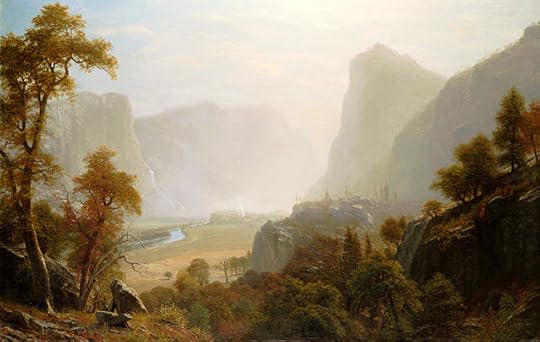 The Hetch-Hetchy Valley, California, 1870s, oil on canvas by German-American artist Albert Bierstadt (1830-1902), currently at the Wadsworth Atheneum Museum of Art, Hartford, CT. (Image courtesy of Wikimedia Commons)
The Hetch-Hetchy Valley, California, 1870s, oil on canvas by German-American artist Albert Bierstadt (1830-1902), currently at the Wadsworth Atheneum Museum of Art, Hartford, CT. (Image courtesy of Wikimedia Commons)I'm really enjoying my $1.99 ebook, John Muir's Ultimate Collection, having recently read the essay "The Hetch Hetchy Valley." This essay chronicles his camping trip into the Hetch Hetchy in 1873, before the fight to keep the Sierra Nevada valley that is near Yosemite from being dammed and flooded for water for the San Francisco area. Muir later rewrote this essay as a plea to not destroy the valley, but the original version I read is more the early writing style of Muir: innocence, wonder, and reverence. (This original essay online here.)
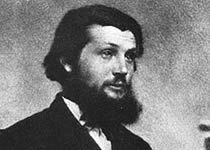 Muir, circa 1860 (PBS)Muir decides to visit Hetch Hetchy during the first week of November, so there is some danger of snow. This, of course, is before satellite weather forecasting, so in his usual inimitable manner, Muir takes three loaves of bread for his food--one for the trip up, one for the trip back, and one for emergencies. He also has his blanket and a nice cup for his "complementary coffee"--Muir, the glamper! "Thus grandly allowanced, I was ready to enjoy my ten days' journey of any kind of calm or storm."
Muir, circa 1860 (PBS)Muir decides to visit Hetch Hetchy during the first week of November, so there is some danger of snow. This, of course, is before satellite weather forecasting, so in his usual inimitable manner, Muir takes three loaves of bread for his food--one for the trip up, one for the trip back, and one for emergencies. He also has his blanket and a nice cup for his "complementary coffee"--Muir, the glamper! "Thus grandly allowanced, I was ready to enjoy my ten days' journey of any kind of calm or storm." He decides to leave the trail and follow some grizzlies to achieve a short-cut in his route, which includes some adventure through the rough country. He's careful, of course, since he doesn't want to startle the bear on a narrow canyon path only wide enough enough for one! "At first I took [the path] to be an Indian trail, but after following it a short distance, I discovered certain hieroglyphics which suggested the possibility of its belonging to the bears," a mother and her cubs. Since the essay was written, readers, you can assume he survived that adventure. Hiking escalates to mountain climbing, all the while Muir describing the experience in his highly readable style that combines travelogue with objective, scientific observation as he adventures all day and then settles in for the night.
"Night gathered, in most impressive repose; my blazing fire illumined the grand brown columns of my compassing cedars and a few withered briers and goldenrods that leaned forward between them, as if eager to drink the light. Stars glinted here and there through the rich plumes of my ceiling, and in front I could see a portion of the mighty cañon walls, dark against the sky, making me feel as if at the bottom of a sea."Muir discusses the history of the valley, its human occupation--and, yes, there is a snowstorm. Our intrepid traveler weathers it, and not alone. "I did not expect company in such unfavorable weather; nevertheless I was visited towards evening by a brown nugget of a wren."
This beautiful, descriptive narrative essay is a tribute to the beauty and glory of the natural world--and unfortunately, also a prescient eulogy to the now-inundated valley. This is Muir at his finest--the minimalist camper, the scientist and naturalist, and the priest of the forest cathedral.
 Enter your email address:
Enter your email address:Delivered by FeedBurner

Published on December 18, 2019 04:54
December 11, 2019
No Pot of Gold in Scorsese's "The Irishman"
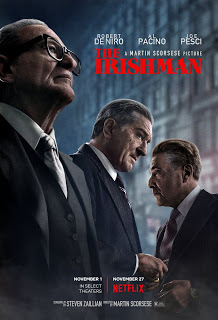 To make a long story--or movie--short, Scorese's and Netflix's movie The Irishman unfolds like a documentary, treating characters and events objectively. This isn't necessarily bad because I enjoy watching documentaries, but the problem is that the intimate, close-up detail of the interactions of the characters carries no emotional weight. I ended up at the end of the movie saying, "Okay, but who cares?"
To make a long story--or movie--short, Scorese's and Netflix's movie The Irishman unfolds like a documentary, treating characters and events objectively. This isn't necessarily bad because I enjoy watching documentaries, but the problem is that the intimate, close-up detail of the interactions of the characters carries no emotional weight. I ended up at the end of the movie saying, "Okay, but who cares?"What "no emotional weight" means can most easily be seen by comparing The Irishman with The Godfather. Both are about Mob business and violence; however, who in The Irishman of the main characters can a viewer emotionally connect with? Russell Bufalino (Joe Pesci)? No, too much reptilian cold-bloodedness. Frank Sheeran (Robert De Niro)? He'd learned to kill in WWII, but many men came home from that war and, even if scarred, didn't become hitmen. Jimmy Hoffa (Al Pacino)? That character's myopic aggression and drive drops him from the dinner invitations list of both the Mob and audience. These three actors and their interplay are truly incredible, and it's a pleasure to watch their nuanced performances as the actors become their characters on screen. But do we care what happens to these characters? Not really, or if we do, it's more credit to the actors and audience than the characters' personalities.
In The Godfather, though, in a world of violence and murder, there exist Michael Corleone (Al Pacino) and his fiance and bride, Kay Adams (Diane Keaton). These innocents, and especially Michael Corleone, provide the readers with characters who can be identified with, innocents who are unwillingly sucked into the mire of the Mob. Even Vito Corleone (Marlon Brando) becomes more accessible because of the relationship between Vito and his son Michael.
In The Irishman, Sheeran's daughter Peggy is the most identifiable. As an adult, Peggy (Anna Paquin) says only seven words, yet she is the witness of the movie, the arbiter of right and wrong. She lacks the time in the movie, though, to carry the audience to its two and a half hour conclusion. At the end of The Irishman, we are left with no epiphany, no pot of gold, only the sense that we watched the lives of these characters unfold, and the only undeserved punishments received were, perhaps, those of the innocent audience watching mobsters get their deserved punishments.
 Enter your email address:
Enter your email address:Delivered by FeedBurner

Published on December 11, 2019 08:36
December 4, 2019
I Read a Graphic Novel. "Spider-Man Noir," and Here's What I Found Out
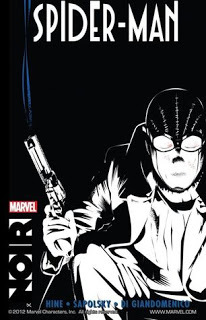 I was browsing at my good old local public library and wanting to try something new. On the way to the fiction section, walking down the central aisle, I passed the small graphic novel collection and thought, "Why not?" I had looked at the graphic novels before but hadn't pulled the trigger and checked one out. Why not try one?
I was browsing at my good old local public library and wanting to try something new. On the way to the fiction section, walking down the central aisle, I passed the small graphic novel collection and thought, "Why not?" I had looked at the graphic novels before but hadn't pulled the trigger and checked one out. Why not try one?I chose a thin book on a subject that I was familiar with and picked up Spider-Man Noir . The graphic novel's text author and goodreads self-reviewer posted the following blurb:
With great power, there must also come great responsibility - and when those in power abuse it, it's the people's responsibility to remove them. The year is 1933, and New York City is not-so-secretly run by corrupt politicians, crooked cops, big businesses . . . and suave gangland bosses like New York's worst, the Goblin. But when a fateful spider-bite gives the young rabble-rouser Peter Parker the power to fight the mobster who killed his Uncle Ben, will even that be enough? It's a tangled web of Great Depression pulp, with familiar faces like you've never seen them before!As anyone can see, the novel's 2009 storyline is familiar and aligned to the familiar characters and events in the Spider-Man movies. However the noir aspect provides a darker and more gritty feel to the novel, captured not so much by the storyline but by the art. The pictured illustrations are literally or visually more dark than many comic books I've read. Spider-Man packs a pistol and wears a costume compiled from old, iconic wardrobe styles of the 1930s--leather bomber helmet, motorcycle goggles, trench coat, and heavy clothes of natural fiber. He can still spit the web, though, and fly through the air with spiderese.
My Conclusions
I found the graphic art of the novel interesting in the depiction of the times, the tone. The illustrations provided powerful and interesting images that concretized the novel's world view.The graphic aspect of the novel didn't help me with the storyline. I do just fine reading a novel that is all text and with no illustrations. The pictures in my head, built through author description of character and setting and my imagination, are the real canvas upon which a textual novel is revealed. There's nothing wrong with a new experience, though, and I enjoyed the read.The comic book "bubble" dialogue and description in this graphic novel were in tiny letters. Some I read by just attending closely, and for some of the novel I pulled out a magnifying glass to read. The size of the text was just small enough to require just enough effort that I was pulled away from the storyline in order to deal with the physical experience of reading.So do I recommend the graphic novel? Sure! I experienced no epiphanies, though. It was pretty much what I expected, just smaller than I expected.
 Enter your email address:
Enter your email address:Delivered by FeedBurner

Published on December 04, 2019 04:38
November 27, 2019
Reading Ernest Hemingway--The Snows of Kilimanjaro and Other Stories
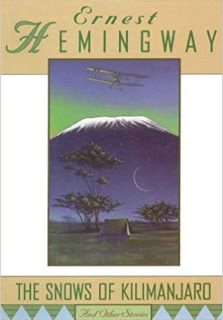 While browsing through my local county library, one of the books I brought home was Ernest Hemingway's
The Snows of Kilimanjaro and Other Stories
. I hadn't read Hemingway for a long time, and I was interested in the experience. And what was my experience? Surprised, pleased, and "Oh, yeah, I remember."
While browsing through my local county library, one of the books I brought home was Ernest Hemingway's
The Snows of Kilimanjaro and Other Stories
. I hadn't read Hemingway for a long time, and I was interested in the experience. And what was my experience? Surprised, pleased, and "Oh, yeah, I remember."The collection is one that the publisher Simon and Schuster gleaned from his published short stories, the first being the title short story. I read the first three stories and plan to read the rest a bit at a time over time. What surprised me what how the stories pulled me in. The action was not intense, but the characters and their dilemmas captured me. Time and storyline took a backseat to the perspective of the characters. I had forgotten, what with my current interest in more popular fiction, especially whodunits, that one can just enter the world of fiction and live for a time with the characters, just hang out in their reality. Reading Hemingway, I found his simple, straightforward phrasing again pulled me into his reality, his human, imperfect world.
I was pleased to remember again the experience of reading "literature," that is, fiction that is not written primarily to entertain or thrill (although it must, to an acceptable degree, do both) but more to open the world to the reader, to unify the outer and inner worlds. The best writing opens the world, widens it, places us, the readers, in that larger world--expands us. Hemingway's stories, these gems, did this. I was reminded of my humanity--the stories didn't allow me to escape but rather to remember. The main purpose of the stories was to open the reader to that moment of epiphany, when we for a moment touch the greater realities of existence.
However, there was also that "Oh, yeah" moment I remembered about Hemingway. I suppose most reading this will know about his depression, his alcohol, his suicide. Each of the three stories in this collection are all associated with death. I was reminded that "beauty" is not the same as "pretty." These stories are beautifully crafted; they move us, increase us. They are not pretty, though. The uplift we experience is from the art of the story, not the content, which is dark. I had forgotten and then remembered while reading the heaviness of Hemingway's vision, Hemingway's stoicism in the face of suffering, mostly self-imposed. Reading Hemingway is like taking a bitter tonic. It may be good for you, but only in small, occasional doses.
That's why I returned the book to the library. I'll check it out again, read a few stories over the next month, renew it, and then probably finish the stories. It's like that old movie cliché where the hysterical character gets his face slapped and then says, "Thanks, I needed that." Or perhaps it's a glass of cold water tossed in your face (the water, not the glass). An artful rendering of our mortality can remind us to live life more fully, to appreciate each moment, but too much can overwhelm. That's why I'll be reading this collection of short stories a few at a time. "Ah, yes, I remember," I'll say to myself, uplifted by Hemingway's mastery of his craft, and then I'll walk outside and stand in the sun, the light warm against my face.
Easy Follow This Blog by Email
 Enter your email address:
Enter your email address:Delivered by FeedBurner

Published on November 27, 2019 04:32
November 23, 2019
Review: The Man in the High Castle
 The Man in the High Castle is set in an alternative history universe that vividly describes a hideously transformed America, yet the most compelling aspect of this Amazon series is how it focuses on individual choice rather than panoramic spectacle.
The Man in the High Castle is set in an alternative history universe that vividly describes a hideously transformed America, yet the most compelling aspect of this Amazon series is how it focuses on individual choice rather than panoramic spectacle.The Man in the High Castle has run four seasons to its end. Based on the novel by Philip K. Dick of the same name, the alternative reality series is an exploration of how our choices shape our own lives.
In a dystopian America dominated by Nazi Germany and Imperial Japan, a young woman discovers a mysterious film that may hold the key to toppling the totalitarian regimes. (IMdb)Yes, time is spent on the struggle against genocide, racism, and the exploitation of the weak and poor. The totalitarian disregard for the weak and "different" is omnipresent in the series, yet time and again individual choice captures the moment, individual perspective and choice, even when mired in the miasma of repression.
Some characters are broken; some grow stronger. Some find themselves, decision by decision, becoming the monsters they despise. At one point in the series, a man and wife recognize that they have to stop doing such terrible things. One responds, "I don't know how." This ambivalence is a central theme in the series, that for better or worse, we create our own realities. Protagonists become anti-heroes, failed heroes. Minor characters make world-changing decisions; some die, some transform into major characters.
The extreme hazards of this alternate world's reality constantly raises question. "What are you willing to die for?" "Are you willing to risk your death and your family's dying for the chance of their not living in hell?" "At what point does biding your time become capitulation?" "Have we saved our children's bodies but destroyed their souls?"
In the end, we are given hope yet are never for a moment allowed to forget that this is a cautionary tale, that every choice we make--or don't make--creates the world we live in.

Published on November 23, 2019 09:38
October 3, 2019
John Muir's "Snow-Storm on Mount Shasta"
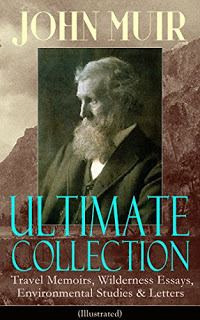 For a couple of bucks I've bought the e-book John Muir Ultimate Collection. My first dip into this collection is "Snow-Storm on Mount Shasta."
For a couple of bucks I've bought the e-book John Muir Ultimate Collection. My first dip into this collection is "Snow-Storm on Mount Shasta."I have not finished this piece, but am reminded that Muir's roots as a naturalist stand side-by-side with his narrative capabilities as a writer. This piece begins with the geological history and description of Mount Shasta, a volcano in northern California. After a thorough description of the geology of the area, Muir continues on with an overview of the different zones of vegetation. Then he warms up to the narrative of his and a companion's climb to Shasta's summit in the April spring to conduct barometric pressure readings, in conjunction with a college at the base of the mountain.
A lively blend of observation and action ensues, with the two men reaching the top summit, where they observe clouds forming and blanketing the entire area. What with the title of the article, we know what is coming . . . wind, snow, and more exquisite narration by John Muir.
I leave the how Muir's great, true adventure ends to your reading, but of course we know Muir made it out alive to write the article. We'll experience considerably more fair weather reading about his exploits from our armchairs at home, where nothing is a better read than Muir upon the snowy, wind-swept heights of California peaks.
Other articles I've written about John Muir:
My First Summer in the Sierra: John Muir (an excerpt) [Jan. 4, 2011]An excerpt from "My First Summer in the Sierra," by John Muir, 1869.". . . to see the behavior of the fall all the way to the bottom": John Muir climbs to the edge of Yosemite Falls [Jan. 10, 2011]A Thousand-Mile Walk to the Gulf, by John Muir: a book review [June 20, 2011]
 Enter your email address:
Enter your email address:Delivered by FeedBurner

Published on October 03, 2019 07:03
September 16, 2019
Travelogues and Tiny Trailer Travel
 Howell Station Campground, Lake Red Rock, IowaFunnily enough, it is four years ago that I wrote a blog article entitled "All Writing Is Travelogue"--and I mean exactly four years ago. The article was published on September 16, 2015, and today, September 16, 2019, I was thinking about travelogue writing and referenced this article. Auspicious or quirky or just random, but I'll go with the flow.
Howell Station Campground, Lake Red Rock, IowaFunnily enough, it is four years ago that I wrote a blog article entitled "All Writing Is Travelogue"--and I mean exactly four years ago. The article was published on September 16, 2015, and today, September 16, 2019, I was thinking about travelogue writing and referenced this article. Auspicious or quirky or just random, but I'll go with the flow.In a week I'll be heading out with my tiny travel trailer on what my wife and I call "scouting missions," where I head out solo to find new campgrounds for us to visit together. When we camp together, my wife needs good cellphone receptivity so that she can use the phone's hotspot to set up her online mobile office for her business. My scouting missions are the search for beautiful camp spots that include a strong phone signal.
I'm planning in a week to leave for a couple of weeks, touring northeast Iowa and specifically scouting out state parks that will fit our family's recreation and business needs. In my earlier article about travelogue, I begin with the following premise: "When writers put down words, they take readers on a journey. In this sense, all writing falls into the 'travelogue' genre, the chronicle of a journey, first the writer's journey of discovery and then the reader's." Four years later, I have no problems with that premise, although I might add that the journeys writers and readers take can have a focus. "How-to" articles have an intellectual and practical focus. Biographical and geographical articles can have a social focus. All writing, whether fiction or non-fiction, has to provide emotional connection to the individual. Writing in some way has to be transformative.
In my "All Writing Is Travelogue" article, I reference a travel blog, The Travel Writing Life, written by a woman, Laurie Gough. It's ironic that her blog is now shut down or "parked" and no longer accessible. I remember, though, Gough's descriptive passages of her travels, and thank her for her inspiration. I hope she is doing well. One article from her blog delineated points for good travelogue writing.
Travel Writing Tips
Focus on interesting, different, and special qualities. "Usually this will be a combination of the place and the people."Concrete details: "not 'fruit' but 'rotting pomegranates.'""Stay true to who you are." Let the readers find out as you go along.Open your senses to the small things: oil-burning lamps, newly cut timber, cricket chirps . . .Characterization: "How human beings are acting on this planet never fails to enliven a story."Find the good, even in the lousy.Backstory: history, facts, past events."Read your work aloud to yourself."Tone/mood:"Take in as much of a place as you can."I need to take these tips to heart, and thank you again, Laurie Gough. I spent a little less than a week at the campground in the photo above, and wrote the article "Howell Station Tiny Trailer Basecamp" for my travel trailer blog, Green Goddess Glamping. I think the writing tips listed above are good to remember and to consciously apply.
 A beautiful meadow setting at Howell StationIn my Howell Station article, I believe I provided backstory about the lake and Pella, Iowa. I think I missed the "tone/mood" a bit because it was, at least for me, an interesting experience to be camping below Lake Red Rock Dam. The campground is a beautiful meadow with soft morning and evening light, deciduous trees, walnuts, oak, and maple, providing shade during the afternoon. I could have captured that mood better.
A beautiful meadow setting at Howell StationIn my Howell Station article, I believe I provided backstory about the lake and Pella, Iowa. I think I missed the "tone/mood" a bit because it was, at least for me, an interesting experience to be camping below Lake Red Rock Dam. The campground is a beautiful meadow with soft morning and evening light, deciduous trees, walnuts, oak, and maple, providing shade during the afternoon. I could have captured that mood better. Des Moines River at Howell Station CampgroundThe Des Moines River flows past the campground, adding its liquid background growl to the setting. However, there was always a quiet background awareness of all that water above me, behind the dam. Lake Red Rock is Iowa's largest lake, with over 15,000 acres of water. Maybe it's just me, but if I put my attention on it, I could kind of feel that mass of water lurking over me. Luckily, the five nights at the campground provided a chance for me to get used to the three-dimensionality of the landscape.
Des Moines River at Howell Station CampgroundThe Des Moines River flows past the campground, adding its liquid background growl to the setting. However, there was always a quiet background awareness of all that water above me, behind the dam. Lake Red Rock is Iowa's largest lake, with over 15,000 acres of water. Maybe it's just me, but if I put my attention on it, I could kind of feel that mass of water lurking over me. Luckily, the five nights at the campground provided a chance for me to get used to the three-dimensionality of the landscape.I believe I could have spent more effort adding more sense detail and description for both my basecamp experience and for my bike day rides. I added some, but more conscious application of this aspect of writing should always be part of my revising process. I included some bits about me--"staying true to me"--such as when I got lost. I could have added more characterization since I had some good interactions with a variety of people.
 I enjoyed my bike ride to Pella, although I found this fellow not much of a conversationalist. I'm looking forward to my tour of state parks. Northeast Iowa is an area missed by glaciers, so the terrain is different than my local area. Also, some of the parks will be on the mighty Mississippi River and should provide some spectacular panoramas. We'll see how the trip and the writing goes, but it should be a bit cooler and more pleasant--the weather, that is. Below are links for the state parks I plan to visit. I will be flexible, but I plan to spend two nights at each park. If a park is really spectacular, I will spend longer; if underwhelming, I can just do an overnighter. I feel no compulsion to have a plan and to stick to it point for point. Palisades-Kepler State ParkBackbone State ParkPikes Peak State ParkMaquoketa Caves State ParkWildcat Den State ParkGeode State ParkRivers, lakes, hills, caves, and the amenities of the state parks. I should have some good times. Most of the campgrounds will have modern facilities, but Wildcat Den is a primitive site, so I will have my first experience of camping off the grid with the Green Goddess--my "hard-sided tent." I have a week's work now to get my garden tucked away for the winter and to prepare for my trip. Traveling solo, I should have many opportunities to focus on the details of travelogue writing. I'm writing this now at dawn from my home, and the fields are covered with fog, dyed pale shades of pink and gray by the rising sun. It's a beautiful world, and I'm looking forward to chronicling my adventure.
I enjoyed my bike ride to Pella, although I found this fellow not much of a conversationalist. I'm looking forward to my tour of state parks. Northeast Iowa is an area missed by glaciers, so the terrain is different than my local area. Also, some of the parks will be on the mighty Mississippi River and should provide some spectacular panoramas. We'll see how the trip and the writing goes, but it should be a bit cooler and more pleasant--the weather, that is. Below are links for the state parks I plan to visit. I will be flexible, but I plan to spend two nights at each park. If a park is really spectacular, I will spend longer; if underwhelming, I can just do an overnighter. I feel no compulsion to have a plan and to stick to it point for point. Palisades-Kepler State ParkBackbone State ParkPikes Peak State ParkMaquoketa Caves State ParkWildcat Den State ParkGeode State ParkRivers, lakes, hills, caves, and the amenities of the state parks. I should have some good times. Most of the campgrounds will have modern facilities, but Wildcat Den is a primitive site, so I will have my first experience of camping off the grid with the Green Goddess--my "hard-sided tent." I have a week's work now to get my garden tucked away for the winter and to prepare for my trip. Traveling solo, I should have many opportunities to focus on the details of travelogue writing. I'm writing this now at dawn from my home, and the fields are covered with fog, dyed pale shades of pink and gray by the rising sun. It's a beautiful world, and I'm looking forward to chronicling my adventure. Enter your email address:
Enter your email address:Delivered by FeedBurner

Published on September 16, 2019 10:14
September 1, 2019
Scratch That Writer's Itch
 Blog writing that is shared with a particular, lively community is a rewarding writing endeavor. I've been writing my little blog, Green Goddess Glamping, about tiny travel trailers and camping, for a year now.
Blog writing that is shared with a particular, lively community is a rewarding writing endeavor. I've been writing my little blog, Green Goddess Glamping, about tiny travel trailers and camping, for a year now.That year of writing produced over 50,000 page views for my blog and one hundred email subscriptions. Now, I realize this isn't much compared to some blogs, but for my individual efforts, I find this modest success rewarding. The important things for me, though, is a consideration of the most basic definition of "writer." A writer is one who writes, and my success with Green Goddess Glamping has provided me an audience, allowed me to write about my interests, and has just provided me a fun time steadily writing. That's good because I feel that the steady flow of ideas and words on the page aids my creativity. The educational, higher order thinking skill term is fluency: many and diverse ideas.
 Green Goddess GlampingHowever, I've been thinking about short stories I've written and ones that are still in the draft stage, stories based in the Dragons of Blood and Stone universe. There are some that I'd like to finish polishing, and some I'd like to develop. Looking at the map of my made-up universe, ideas are popping for a few new stories. Soon my wife and I are heading out for a ten-day camping trip. Maybe I'll take a peek at that short story draft, entitled "Blade" right now.
Green Goddess GlampingHowever, I've been thinking about short stories I've written and ones that are still in the draft stage, stories based in the Dragons of Blood and Stone universe. There are some that I'd like to finish polishing, and some I'd like to develop. Looking at the map of my made-up universe, ideas are popping for a few new stories. Soon my wife and I are heading out for a ten-day camping trip. Maybe I'll take a peek at that short story draft, entitled "Blade" right now.A little change is always good, and "Blade" is set in the wilderness . . .

Published on September 01, 2019 03:46
August 29, 2019
Elizabeth Warren Should Not Be Ashamed of Her Native American Heritage Mistake
 MomLet me tell you a personal story.
MomLet me tell you a personal story.My mother was adopted, and as a teenager wrote to the state of Kansas and acquired her original birth certificate. This was probably around 1940. My grandmother didn't want my mother to do this because she felt it wasn't important, but my mother, being curious and a teenager, went ahead and got the birth certificate anyway. On the certificate, my maternal, genetic grandfather's race is listed as "part Indian."
Think of the history of Native Americans and the history of indigenous people all over the world. What does "part Indian" mean? Decimated by disease and violence, cultures actively destroyed with government sanction, tribes displaced and disbanded, use of native language forbidden--my "part Indian" genetic grandfather could have belonged to any tribe. I don't even know if on that birth certificate the "part Indian" designation was my grandfather's terminology or whether my grandfather had stated his tribal name and the clerk had just decided that "Indian" was good enough. The information is vague enough that I don't even know for certain how accurate that designation is--or if it was accurate at all. What if the story told to my grandfather was just inaccurate family legend? Or what if there were some truth, but that truth so far in the past or such a small part of the past as to be meaningless?
Let me tell you one more story, a quick one.
My father told the story that our family name of Kepler was a direct link to the German mathematician Johannes Kepler, best known for establishing his laws of planetary motion. Johannes Kepler was born December 27, 1571. My dad told the story that Johan's brother was a Hessian soldier during the American Revolutionary War, and that when he came to America to fight, the war was over. That first American Kepler of our line, so our family legend goes, deserted by hiding in a hogshead barrel on the docks, ran off, and became an American resident. That's a great family story, but probably some of you good at math (like Johannes Kepler) will note that the timeframe is about two hundred years off for Kepler's brother to be connected to American independence. That doesn't mean there might not be some germ of truth to the legend, though, that some distant relative of the mathematician didn't ship off to fight those rabble-rouser Americans. As a teenager, I went pretty much the same route as my mom had regarding her heritage--I researched and discovered that the Hessian Kepler soldier shipping overseas was definitely not the mathematician's brother. The time frames didn't.
These stories are a part of my past, and my connection to them is quite honestly not to those distant ancestors (real or not) but to my parents. I remember them telling me the stories, my mom telling me how she asked for her teacher's help in obtaining the address and agency for her inquiry, and help on how to write the letter. This spunky behavior by my mom was especially poignant because my mother had very poor eyesight from a childhood injury and had difficulty in school, although she did well. I remember my father telling me the Hessian soldier story and how much he enjoyed doing so. He was a joke teller and a storyteller, and it was a real sharing moment between us.
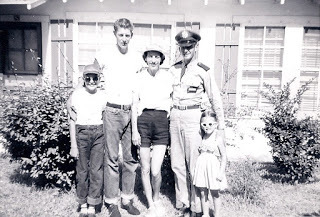 Elizabeth Warren and her mom and brothers
Elizabeth Warren and her mom and brothersElizabeth Warren grew up with similar circumstances--family stories explaining her heritage, stories that were not accurate. Warren was recently asked about her credibility toward people of color, since when in college she had referenced her family legends, which with recent DNA analysis were determined to be inaccurate. She responded at a New Hampshire candidate forum, as reported by the online website The Hill.
Whether or not my Native American genetic heritage is significant in my DNA or not, those two words on my mother's birth certificate, "part Indian," did have a big impact in my life. I will most likely never know what tribe my heritage connects to. That knowledge is lost. The fact that I have lost knowledge of my family's past has been an impetus, though, since my teenage years to learn more about Native American history. It has influenced my understanding of spirituality and of my relationship with the natural world. Those two words and my mother's stories have influenced who I am. My genetic grandfather died in an automobile accident and my genetic grandmother, a nurse, could not work and raise my mother, so my grandmother gave my mother to my adoptive grandparents, who had not been able to conceive. My mother told that story so sweetly and simply.Warren responded that she was told about her family heritage by her parents and cited a Boston Globe investigation from last year that found that her ethnicity played no factor in advancing her academic career.“Like most people, my brothers and I learned about who we are from our mom and our dad. My family’s very important to me, and based on that, sometimes, decades ago, I identified that way. But nothing about the way I identified ever had anything to do with my academic career,” Warren said.“Even so, I shouldn’t have done it. I am not a person of color. I am not a citizen of a tribe, and I’ve apologized for any confusion over tribal sovereignty, tribal citizenship and any harm caused by that,” she continued.
Elizabeth Warren has established a Fact Squad page to "Fight back against the lies, smears, and wacky conspiracy theories making the rounds about Elizabeth and this grassroots team. Fact Squad gives you all the information you need to respond to every lie with the truth."
On that site is referenced The Boston Globe's assertion that genetic claims were no part of Warren's work history.
Fact: Elizabeth Warren's heritage played no role in her hiring. In the most exhaustive review undertaken of Elizabeth Warren's professional history, The Globe found clear evidence, in documents and interviews, that her claim to Native American ethnicity was never considered by the Harvard law faculty, which voted resoundingly to hire her, or by those who hired her to four prior positions at other law schools. At every step of her remarkable rise in the legal profession, the people responsible for hiring her saw her as a White woman.Warren has recently proposed a "lengthy and exhaustive policy plan" to address Native American issues, which has been reported by many sources, among them ABC News. I am still watching closely the Democratic candidate race for the presidency. I have to say, though, that I admire that Warren discovered her family legends to be inaccurate, fessed up, and is now moving forward to improve the situation for Native Americans. As Americans, we can and should feel some connection to all the different people who comprise our nation.
That's what makes us American--our heritage is conceptual, not genetic or cultural. Warren's positive, inclusive spirit is what America needs. I'm not sure at this point whom I will vote for in the presidential election. We all make mistakes, and I'm reassured to know that there are candidates who are willing to admit mistakes, to rectify errors, and then to move on in a positive, constructive manner.

Published on August 29, 2019 03:15



